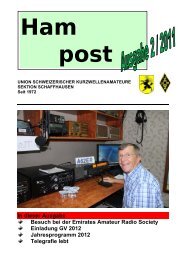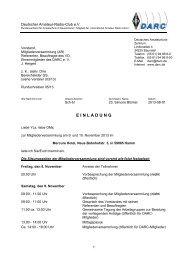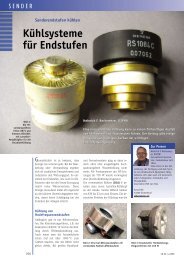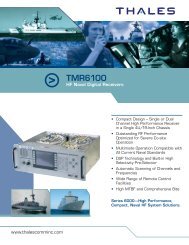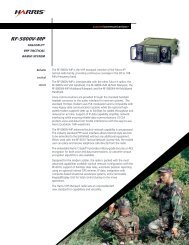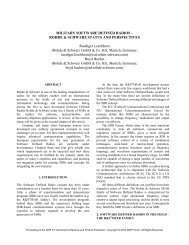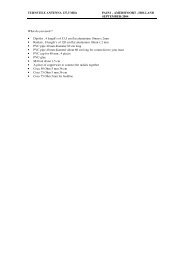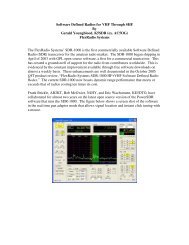Rohde & Schwarz M3TR - QSLNET.de
Rohde & Schwarz M3TR - QSLNET.de
Rohde & Schwarz M3TR - QSLNET.de
You also want an ePaper? Increase the reach of your titles
YUMPU automatically turns print PDFs into web optimized ePapers that Google loves.
EPM (ECCM)<br />
waveforms<br />
R&S®SECOM-V and R&S®SECOM-H<br />
The R&S®SECOM waveform (R&S®SECOM-V for the VHF<br />
and UHF bands, R&S®SECOM-H for HF) with its high hop<br />
rates and secure synchronization is setting new standards.<br />
It ensures powerful protection against <strong>de</strong>tection, interception,<br />
jamming and spoofing. User data (digital voice or<br />
data) is transmitted completely digitally and in encrypted<br />
form. Within one R&S®SECOM-V net, several subnets and<br />
sublinks can be established simultaneously in the pointto-point<br />
and point-to-multipoint mo<strong>de</strong>s. Network synchronization<br />
and access can be planned and controlled individually<br />
for each user. Methods such as late net entry or<br />
hailing (R&S®SECOM-V) are available for this purpose.<br />
R&S®SECOM is a combination of COMSEC and TRANSEC<br />
for encrypted voice and data communications in the<br />
frequency -hopping mo<strong>de</strong>.<br />
The COMSEC part of the R&S®SECOM method is based<br />
on the R&S®RSCA crypto algorithm <strong>de</strong>veloped by<br />
<strong>Roh<strong>de</strong></strong> & <strong>Schwarz</strong>. The method uses key lengths of up to<br />
256 bit (approx. 10 77 variants). Assuming uninterrupted<br />
transmission, the same bit sequence would be repeated<br />
after about 2 × 10 9 years. The keys required can be distributed<br />
by means of a key distribution <strong>de</strong>vice or directly<br />
from a PC. All keys are encrypted and the <strong>de</strong>ciphered<br />
original is present only in the read-protected security processor.<br />
Crypto units complying with NATO standards such<br />
as ELCRODAT 4‐2/R&S®MMC3000 may be used as an<br />
external option.<br />
To plan communications networks and links, a PC-based<br />
radio network management system is available. This<br />
tool allows users to generate keysets, plan frequency resources,<br />
<strong>de</strong>fine user channels and services and set up<br />
complete networks of radios. After the <strong>de</strong>sired networks<br />
have been <strong>de</strong>fined, the resulting data can be easily distributed<br />
to the radios by means of a fillgun or directly by using<br />
one of the radios’ data interfaces.<br />
R&S®SECOM-V (R&S®GS3030S)<br />
R&S®SECOM is optimized for tactical communications<br />
and operates in the full VHF/UHF band. It is implemented<br />
as a software option running on all R&S®MR300xH/<br />
R&S®MR300xU tactical radios.<br />
R&S®SECOM-V was <strong>de</strong>veloped to meet as closely as possible<br />
the network <strong>de</strong>mands of the primarily land-based<br />
mobile users of tactical radio services. R&S®SECOM-V is<br />
attuned to the requirements of land forces, where the implementation<br />
and management of complex network structures<br />
are in the foreground. The primarily hierarchical command<br />
structure of the armed forces should be mapped as<br />
closely as possible to the communications network. To this<br />
end, users can be organized in networks using the same<br />
frequency pool and the same key – one each for TRANSEC<br />
and COMSEC.<br />
Possible address mo<strong>de</strong>s are point-to-point, point-to-multipoint<br />
and broadcast. Network synchronization and access<br />
can be controlled by each user. Late net entry is available<br />
for this purpose.<br />
R&S®SECOM-V automatic net entry and time beacon<br />
The radio automatically performs a net entry whenever<br />
synchronization is lost (R&S®M300xU/R&S®M300xH<br />
display message: NSYN). The time reference unit of an<br />
R&S®SECOM-V net automatically takes care of maintaining<br />
synchronization before it is lost. If the time beacon function<br />
is not active, a net entry may need to be performed<br />
from time to time.<br />
R&S®SECOM-V out-of-band hailing<br />
Out-of-band hailing is an outstanding feature that consi<strong>de</strong>rably<br />
enhances the multiband capabilities of the<br />
R&S®<strong>M3TR</strong> radio with cross-band hailing. The latest software<br />
release makes it possible to scan FF calls over the<br />
entire frequency range from 1.5 MHz to 512 MHz. This<br />
means real multiband operation, as even HF calls can be<br />
received while operating the radio in the VHF/UHF range.<br />
All FF modulation and squelch mo<strong>de</strong>s for the <strong>de</strong>tection of<br />
signals are supported.<br />
<strong>Roh<strong>de</strong></strong> & <strong>Schwarz</strong> R&S®<strong>M3TR</strong> Software Defined Radios 17




